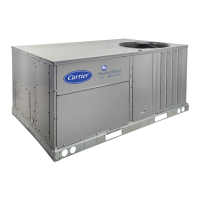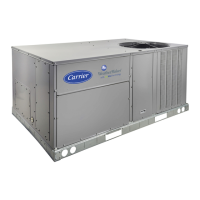37
over the first 5 seconds, mechanical cooling will be shut down,
and an alarm will be generated (A140). This alarm requires a
manual reset.
If the unit is in the Service Test mode, the test will be per-
formed any time a compressor is energized.
Once it has been verified that power to the rooftop and com-
pressors has been applied correctly and the compressors start
up normally, this configuration can be set to YES in order to
prevent the reverse rotation check from occurring.
High SST Alert Delay Time (H.SST)
This option allows the high saturated suction temperature alert
timing delay to be adjusted.
Outdoor Fan VFD Enable (OV.ENA)
The optional Greenspeed
®
/low ambient control configuration
units with additional outdoor fan speed control option is installed
from the factory. For the unit with Greenspeed/low ambient op-
tion installed, the Outdoor VFD (OV.EN) configuration needs to
be set to YES to fully utilize the function of the optional head
pressure control for improving energy efficiencies or extended
operational ambient conditions. See Head Pressure Control sec-
tion, page 46, for more information.
The non-factory-installed Motormaster V speed control acces-
sory is a completely self-contained device and is not managed
by the unit's ComfortLink controller.
Low Ambient Set Point (LASP)
This is the head pressure setpoint used by the ComfortLink
control during condenser fan staging and maintaining head
pressure control for unit with Greenspeed/low ambient option.
This configuration will have a range of 70 to 150°F and have a
default of 100°F.
COMPRESSOR SAFETIES
The 48/50A Series units with ComfortLink controls include a
compressor protection board (CSB) that protects the operation
of each of the compressors. These boards sense the presence or
absence of current to each compressor.
If there is a command for a compressor to run and there is no
current, then one of the following safeties or conditions have
turned the compressor off:
• Compressor overcurrent — Smaller compressors have in-
ternal line breaks and larger compressors have a dedicated
circuit breaker for overcurrent protection.
• Compressor short circuit — The compressor circuit break-
er that provides short circuit protection has tripped then
there will not be current.
• Compressor motor over temperature — The internal line-
break or over temperature switch has opened.
• High-pressure switch trip — High-pressure switch has
opened.
Alarms will also occur if the current sensor board malfunctions
or is not properly connected to its assigned digital input. If the
compressor is commanded OFF and the Current Sensor reads
ON, an alert is generated. This will indicate that a compressor
contactor has failed closed. In this case, a special mode “Com-
pressor Stuck on Control” will be enabled and all other com-
pressors will be turned off and an alarm enabled to indicate that
service is required. Indoor and outdoor fans will continue to
operate. The first outdoor fan stage is turned on immediately.
The second fan stage will turn on when outdoor-air tempera-
ture (OAT) rises above 75°F or the highest active circuit satu-
rated condensing temperature (SCT) rises above the HPSP and
remains on until the condition is repaired regardless of the
OAT and SCT values.
Any time the alert occurs, a strike is called out on the affected
compressor. If three successive strikes occur the compressor
will be locked out requiring a manual reset or power reset of
the circuit board. The clearing of strikes during compressor op-
eration is a combination of 3 complete cycles or 15 continuous
minutes of run time operation. If there are one or two strikes on
the compressor and three short cycles (ON-OFF, ON-OFF,
ON-OFF) less than 15 minutes each occur, the strikes are reset
to zero for the affected compressor. If the compressor turns on
and runs for 15 minutes straight with no compressor failure,
the compressor strikes are cleared.
Additionally, some units contain Copeland compressors
equipped with advanced scroll temperature protection (ASTP).
A label located above the terminal box identifies Copeland
Scroll compressor models that contain this technology. See
Fig. 4. Advanced scroll temperature protection is a form of in-
ternal discharge temperature protection that unloads the scroll
compressor when the internal temperature reaches approxi-
mately 300°F. At this temperature, an internal bi-metal disk
valve opens and causes the scroll elements to separate, which
stops compression. Suction and discharge pressures balance
while the motor continues to run. The longer the compressor
runs unloaded, the longer it must cool before the bi-metal disk
resets. See Fig. 5.
T
o manually reset ASTP, the compressor should be stopped
and allowed to cool. If the compressor is not stopped, the mo-
tor will run until the motor protector trips, which occurs up to
90 minutes later. Advanced scroll temperature protection will
reset automatically before the motor protector resets, which
may take up to 2 hours.
COMPRESSOR TIME GUARDS
The control will not allow any output relay to come on within
3 seconds of any other output relay. For outputs connected to
the compressors, the control will use a Compressor Minimum
OFF Time of 2 minutes, a Compressor Minimum ON Time of
3 minutes and a Minimum Delay before turning on another
compressor of 10 seconds.
Fig. 4 — Advanced Scroll Temperature
0
10
20
30
40
50
60
70
80
90
100
110
120
0 102030405060708090
Recommended Cooling Time
(Minutes)
Compressor Unloaded Run Time (Minutes)
*Times are approximate.
NOTE: Various factors, including high humidity, high ambient tem-
perature, and the presence of a sound blanket will increase cool-
down times.
Fig. 5 — Recommended Minimum Cool-Down
Time after Compressor is Stopped*

